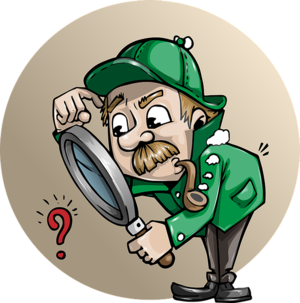Sluething for Truth
Written for TEOLAWKI Times, this article playfully explains the initial process for choosing articles for this website.
***
Today, “news” is a morass. Much of it – the portion termed “mainstream” or “real” – is deliberately designed to scare, ensnare, overwhelm, rile, titillate, cajole, distract, daze and confuse us into believing things that just aren’t true. The now gigantic and still growing “alternative” press offers a mélange of choices from “flat earth” blogs to what was once respectfully referred to as “investigative journalism” but now is derided by the “mainstream” (see above) as “fake news” or “Russian trolling”.
Well, everyone loves a good mystery, right? I do! A Holmes fan for over half a century, I find the daily challenge exhilarating. With my virtual deerstalker and magnifying glass ensconced next to my computer, I pour a cup of steaming spicy chai, set out for a battle of wits with the unarmed Lestrades of the MSM, and the game is afoot. Makes my day! I’ll show you what I do to vet an article for this website in hopes of inspiring you to join the game of Amateur Consulting Detective in the Mystery of the Daily News Morass.
Scene 1: The Title
- Does it make sense? (Sometimes I scan the article because the title doesn’t make sense.)
- Does it promise to add information we don’t already have but would like to?
Scene 2: The Author
- Known
- Credible – ok
- Unreliable – Pass or scan. Look for the same topic covered by reliable journalists.
- Unknown
- Find / read bio
- Main$tream connections (Harvard, Yale, U Chicago, Oxford; Wall, DC) Move on to the same topic covered by reliable journalists. Or, read with curiosity and caution; verify information.
- Alternative press connections, freelance, vitae available – ok
- Find / read bio
Scene 3: Website
- Known
- Credible – ok
- Unreliable – Read warily with curiosity as to why the author is on this site. Look for the same topic covered on reliable sites.
- Unknown
- Go to ABOUT where the name(s) of the website’s owner(s) and funding source are kept. Follow the money.
ABOUT is sometimes on the top menu. Click on the CEO and especially the CFO for a clue. Degrees from Yale, Harvard, or U of Chicago, time served at Wall Street investment firms or NYC/DC corporate law offices, or backgrounds at government-affiliated tech giants like Google, Facebook indicate an agenda to manipulate and use the reader for profit/power, not to serve or inform.
Sometimes locating ABOUT in order to apply the steps above requires visiting the very bottom of the page – a lot like “boldly going where no one has gone before.” Besides ABOUT, the bottom line yields the copyright – another clue. This is where sleuthing becomes more challenging and fun!
Finding a Creative Commons notice here is a gold star for the website. Whoever put this site together is probably in it to provide information for the public good. Finding a phrase like, “an ACME company” means the trail doesn’t end here on this website. Click on or search the named company, find ABOUT, rinse and repeat, including the bottom of the page. The actual parent company’s ABOUT will definitely yield another clue.
Nonprofits, if not Creative Commons, will usually link to funding source reports or to complete profiles as on GuideStar.org.
Scene Four: The Article Itself
Often I read the article before vetting the website it’s on. Either way, the article itself is the crux of the matter. Here are the clues I look for:
- Content Does it enhance or complement what we’ve already posted?
- Documentation Are substantiating links provided?
- Style Does the writer engage my interest with skillful narrative, pointed satire, or humor edited for grammar, punctuation and accuracy?
- Logic Is it logical and consistent regarding its premises? Or, illogical, e.g., does it present contradictory premises as both true?
- Length Is it succinct and to the point, not belabored?
Scene Five: Mystery solved
This is where Holmes and Watson settle into their armchairs on either side of a cozy fire while Holmes explains the chain of evidence leading to his conclusions.
“It is of the highest importance in the art of detection to be able to recognize, out of a number of facts, which are incidental and which vital,” he warns in The Reigate Puzzle.
For instance, the title, author, and article itself may all be first rate, but found on a second-rate website because it was reposted there from another, more reliable site.
The adventure lies in deciphering which writers are guilty of plying their trade for personal gain in service to those who manipulate, surveil and delude the general public for profit and power. There is no dearth of offenders, an unfortunate fact despite the entertainment their unmasking provides.
More enjoyable is discovering and championing writers and videographers whose legitimate intent is to inform, empower or inspire people. They often work at little or no pay and may be subjected to ad hominem and DoS attacks, deplatforming and double standards. It’s satisfying to underscore their professionalism and valor in the face of such aggression.
Those legitimate journalists who are also skilled wordsmiths are those we choose for the TLA site. And each day’s news cycle brings me another chance to play Amateur Consulting Detective.
I’ll look for you online tomorrow afternoon when, once again, the game is afoot!



